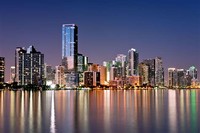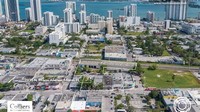Facts about Miami

The Miami area was first inhabited for more than one thousand years by the Tequesta Indians, but was later claimed for Spain, in 1566, by Pedro Menйndez de Avilйs.

The northern side of Miami includes Midtown, a district with a great mix of diversity, with many West Indians, Hispanics, bohemians, and artists.

The highest crime rates were in the late 1970s and early 1980s during the "Cocaine Cowboy" era, since Miami was where the majority of cocaine and crack entered the United States from Colombia.

The newest addition to the Miami arts scene is the Adrienne Arsht Center for the Performing Arts, the second-largest performing arts center in the United States after Lincoln Center in New York City.

Miami is the southern terminus of Amtrak's Atlantic Coast services, with its final station located in the suburb of Hialeah.

Miami is the county seat of Miami-Dade County, the most populous county in Florida.

Public transportation in Miami includes commuter rail, heavy-rail rapid transit, an elevated people mover (Metromover), and buses.

Miami has the largest Spanish-speaking population in the Western Hemisphere outside Latin America.

Miami also has one of the largest percentage populations in the U.S. that have residents who speak first languages other than English at home, 74.54 percent.

Miami’s skyline ranks third in the United States, behind New York City and Chicago, and 18th in the world according to the Almanac of Architecture and Design.

Miami is regarded as more of a multicultural mosaic, than it is a melting pot, with residents still maintaining much, or some, of their cultural traits.

In 2004, the United Nations Development Program (UNDP) ranked Miami first in terms of percentage of residents born outside of the country it is located in (59 percent), followed by Toronto (50 percent).

The city's Port of Miami is known to accommodate the largest volume of cruise ships in the world and is the home port and headquarters to many cruise lines.
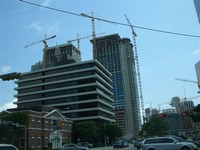
Miami is the headquarters and main production city of many of the world's largest television networks, broadcasting companies and production facilities, such as Telemundo, TeleFutura, Mega TV, Univision, RCTV International, and Sunbeam Television.

Miami is also one of the least affordable places to live; the median percentage of housing costs as a percentage of income was 42.8 percent; the national average was 27 percent.
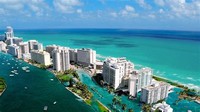
Miami receives one of the highest levels of rainfall among major U.S. cities.

After Fidel Castro rose to power in 1959, many Cubans sought refuge in Miami, further increasing the population.

Miami is the home to the National Hurricane Center and the headquarters of the United States Southern Command, responsible for military operations in Central and South America.

In 2008, Miami was ranked as "America's Cleanest City" according to Forbes magazine for its year-round good air quality, vast green spaces, clean drinking water, clean streets, and city-wide recycling programs.

Miami International Airport, one of the busiest international airports in the world, is the main airport serving the Miami metropolitan area, catering to over 35 million passengers a year.

Miami was officially incorporated as a city on July 28, 1896, with a population of just over 300.

Miami has Florida's highest transit ridership as about 12 percent of Miami's population uses transit on a daily basis.

Miami’s explosive population growth in recent years has been driven by internal migration from other parts of the country as well as by immigration.

Miami has a true tropical climate with hot and humid summers and warm, mostly dry winters.

The western side of Miami includes Little Havana and is home to many of the city's traditional immigrant neighborhoods.

Miami is ranked as a global city for its importance in finance, commerce, media, entertainment, arts, and international trade.

The communities have grown to a prominent place in Miami and its suburbs, creating ethnic enclave neighborhoods such as Little Haiti, Little Havana, Little Managua, Little Brazil, Little Moscow, and Little San Juan.

In 2005, the Miami area witnessed its largest real estate boom since the 1920s.

In 2008, Miami was also ranked the third-richest city in the United States in purchasing power and the world's 22nd-richest city in a UBS study.

Miami International Airport and the Port of Miami are among the nation’s busiest ports of entry, especially for cargo from South America and the Caribbean.

The Miami area was better known as “Biscayne Bay Country” in the early years of its growth.
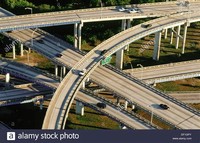
At only 35.68 square miles (92 kmІ) of land area, Miami has the smallest land area of any major U.S. city with a metro area population of at least 2.5 million people.
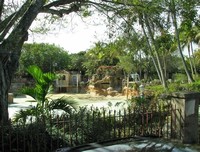
Coconut Grove, established in 1825, is the location of Miami's City Hall, many nightclubs, bars, restaurants, and bohemian shops, and as such, is very popular with local college students.
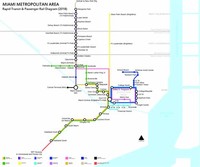
Miami and its metropolitan area grew from just over one thousand residents to nearly five and a half million residents in just 110 years (1896-2006).

Nevertheless, in the latter half of the twentieth century, Miami became a major international, financial, and cultural center.

The northern side of Miami also has notable African-American and Caribbean immigrant communities such as Little Haiti.

Miami is partitioned into many different sections, roughly into North, South, West and Downtown.

Miami and its suburbs are located on a broad plain between the Everglades and Biscayne Bay that extends north to Lake Okeechobee.

The United Nations estimated in 2007, that Miami had become the fourth largest urbanized area in the country, behind New York City, Los Angeles, and Chicago.

The war helped to expand Miami’s population; by 1940, 172,172 people lived in the city.

In 1836, he approved the Siete Leyes (Seven Laws), a radical amendment to the constitution that institutionalized the centralized form of government, after which Texas declared independence from Mexico, obtained in 1836.

Miami is home to many entertainment venues, theaters, museums, parks, and performing arts centers.
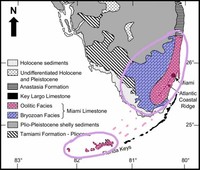
The limestone under Miami formed as the result of drastic changes in sea level associated with recent glaciations or ice ages.

Miami-Dade County is served by four Interstate Highways (I-75, I-95, I-195, I-395) and several U.S. highways.
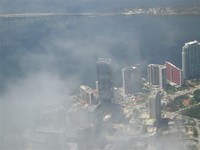
When World War II began, Miami, well-situated due to its location on the southern coast of Florida, played an important role in the battle against German submarines.

Miami is also one of the very few cities where its local government went bankrupt, in 2001.

Miami holds the distinction of being the only major city in the United States founded by a woman, Julia Tuttle, who was a local citrus grower and a wealthy Cleveland native.

Miami is home to one of the largest ports in the United States, the Port of Miami.
South Beach, Miami is rightly famous for its Art Deco architecture. Stroll the streets and feast on the creamy yellow, pink, blue, and purple walls around you, walls flowing into the fanciful shapes of Art Deco style.Jul 10, 2011
Julia Tuttle, a local landowner, convinced Henry Flagler, a railroad tycoon, to expand his Florida East Coast Railway to Miami. On July 28, 1896, Miami was officially incorporated as a city with a population of just over 300.
The hotbed of southern Florida is named after the Mayaimi, a Native American tribe that lived around Lake Okeechobee until the 17th or 18th century. This Minnesota city gets its name from two languages.Aug 24, 2010
The Magic City
About Miami and Miami Beach. Satellite view showing Miami and its suburbs, second largest city (after Jacksonville) in southeastern Florida, USA. The city is located at the mouth of the Miami River at Biscayne Bay on a plain between the Everglades and the Atlantic Ocean.
Miami Beach is a coastal resort city in Miami-Dade County, Florida, United States. It was incorporated on March 26, 1915. The municipality is located on natural and man-made barrier islands between the Atlantic Ocean and Biscayne Bay, the latter of which separates the Beach from Miami.




